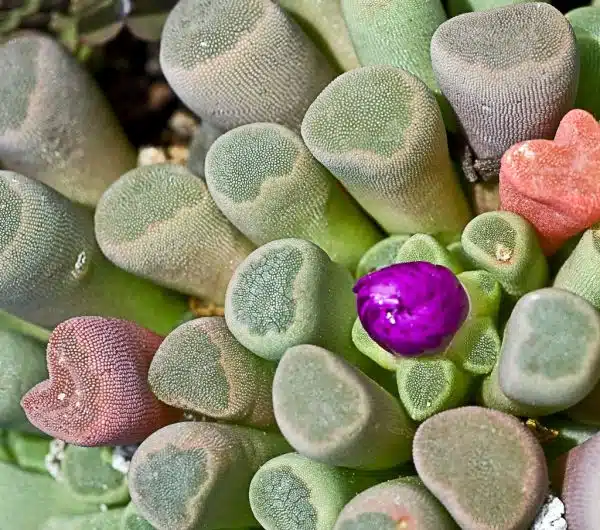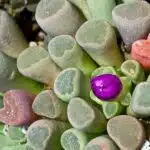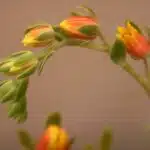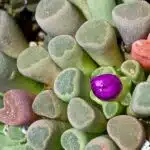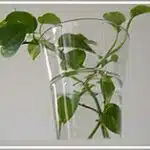Succulents are a popular type of plant that have gained immense popularity in recent years due to their unique appearance and easy maintenance. These hardy plants are native to arid regions and are known for their ability to store water in their leaves, stems, and roots, making them ideal for those who live in dry climates or have limited time for plant care.
In this article, we will provide a comprehensive guide on how to care for succulents, including information on watering, soil requirements, light conditions, and propagation techniques. Whether you’re an experienced gardener or just starting out with your first succulent plant, this guide will offer valuable insights into the world of succulent care and cultivation. So if you’re looking to expand your knowledge on these fascinating plants while also serving others by sharing your newfound expertise, then read on!
What Are Succulents?
Succulents are a type of plant characterized by their thick, fleshy leaves and stems. These plants are well adapted to arid environments and have unique features that allow them to store water for extended periods. Succulent arrangements have become increasingly popular in recent years due to their low maintenance requirements and striking appearance.
Aside from their aesthetic appeal, succulents also offer several benefits for indoor air quality. Research has shown that these plants have the ability to remove harmful toxins from the air such as benzene, formaldehyde, and trichloroethylene. In addition, succulents release oxygen during photosynthesis which can promote better breathing and overall health.
There are many different types of succulents available, each with its own unique characteristics and growing requirements. Some popular varieties include Aloe Vera, Echeveria, and Jade Plant. When selecting a succulent for your home or office, it is important to consider factors such as lighting conditions, soil type, and watering needs.
As we delve into the world of succulents in this guide, we will explore the various types of succulents available along with tips for proper care and maintenance. Whether you’re an experienced gardener or new to the world of plants, there is something for everyone when it comes to these fascinating and versatile plants.
Types Of Succulents
Succulents are a diverse group of plants that come in various shapes, sizes, and colors. They are known for their fleshy leaves and ability to store water, which makes them ideal for dry environments. These plants have become increasingly popular as indoor and outdoor ornamental plants due to their low maintenance requirements and unique appearance.
Indoor vs outdoor succulents: While some succulents can be grown both indoors and outdoors, others require specific growing conditions. Indoor succulents thrive in bright but indirect light, while outdoor succulents need direct sunlight. Additionally, indoor succulents tend to grow slower than outdoor varieties due to the lower light levels. It is important to understand the needs of each plant before deciding where to place it.
Unique varieties of succulents: There are countless unique varieties of succulents available on the market today. Some stand out due to their unusual shapes or colors, while others are prized for their size or rarity. Examples include the string of pearls (Senecio rowleyanus), which has small round leaves that resemble pearls on a string; the panda plant (Kalanchoe tomentosa), with its fuzzy grey-green leaves; and the bishop’s cap (Astrophytum myriostigma), which has a distinctive star-shaped pattern on its surface.
- Five unique varieties of succulents:
- Lithops (Living Stones)
- Echeveria ‘Black Prince’
- Crassula ‘Buddha’s Temple’
- Haworthia Cooperi
- Aloe Polyphylla
Overall, there is no shortage of options when it comes to choosing unique and interesting succulent species for your collection. Whether you prefer indoor or outdoor plants, there is something for everyone! In the next section, we will discuss how choosing the right soil is crucial for growing healthy and happy succulents.
Choosing The Right Soil
Choosing the Right Soil for your succulents is crucial for their growth and overall health. Succulents require well-draining soil that allows water to pass through quickly. The ideal soil composition for succulents consists of a mixture of sand, perlite, and peat moss. This combination creates a light and airy texture that allows air flow to reach the roots while retaining enough moisture to sustain the plant.
When it comes to soil drainage techniques, there are two main options: top dressing and bottom watering. Top dressing involves adding a layer of gravel or rocks at the top of the soil to improve drainage. This method is effective in preventing overwatering and root rot. Bottom watering, on the other hand, involves placing your pot in water up to half an inch deep and allowing it to absorb water from below. This technique ensures that water reaches the roots without saturating the soil.
In summary, choosing the right soil composition and drainage techniques are essential for successful succulent growth. With proper care, succulents can thrive in any environment regardless of their location or climate. Keep in mind that overwatering is one of the most common mistakes when caring for succulents as they require less water than most plants. In the subsequent section, we will discuss the importance of proper watering techniques to ensure your succulent’s longevity and vibrancy.
The Importance Of Proper Watering
Proper watering is one of the most critical factors in keeping succulents healthy and thriving. The amount of water a plant needs depends on various factors such as the plant’s age, size, soil type, humidity, and temperature. In general, succulents require less water than other types of plants because they store moisture in their leaves and stems.
Overwatering is one of the most common mistakes that people make when caring for succulents. It can lead to root rot, which can be fatal for your plant. To avoid overwatering, it’s essential to pay attention to the moisture level of your soil. A good rule of thumb is to let the soil dry out completely before watering again. This will prevent the roots from sitting in wet soil for an extended period.
Underwatering is also a problem that can harm your succulent’s health. If you notice that your plant’s leaves are wilting or shriveling up, it may be a sign that it needs more water. However, it’s important not to go overboard with watering frequency as too much water can lead to problems as well. Always check the soil moisture levels before watering and adjust accordingly.
In summary, proper watering is crucial for keeping succulents healthy and happy. Pay close attention to the soil moisture levels and adjust your watering frequency accordingly. In the next section, we’ll discuss how light and temperature affect succulent growth and provide tips on managing these factors effectively towards promoting optimal growth conditions for your succulent plants.
Managing Light And Temperature
Light requirements for succulents vary depending on the species and can range from full sun to partial shade. Temperature requirements are typically warm, but can also vary by species. Variance in temperature is also important and succulents should not be exposed to extreme cold or extreme heat. The best temperatures for succulents usually range from 65 to 75 degrees Fahrenheit during the day and around 55 degrees Fahrenheit at night. It is important to pay close attention to the light and temperature requirements of a particular species of succulent in order to ensure proper growth and health. Adequate light and temperature is key for a succulent to thrive.
Light Requirements
When it comes to managing light and temperature for succulents, one of the most important factors to consider is their light requirements. Succulents are known for being low-maintenance plants, but providing them with the right amount and type of light is crucial to their growth and health. Natural vs artificial light plays a significant role in this aspect, as well as outdoor vs indoor lighting.
Succulents thrive in bright, indirect sunlight. They need at least six hours of sunlight per day to grow healthy and strong. However, direct sunlight can be harmful to these plants, causing sunburn or dehydration. In cases where natural light is not available or insufficient, artificial light can be used instead. LED grow lights are an excellent choice for indoor succulent growing since they provide full-spectrum lighting similar to natural light.
Outdoor vs indoor lighting also plays a crucial role in succulent care. Outdoor succulents usually receive more intense and direct sunlight than those grown indoors. As such, outdoor plants tend to require less watering than their indoor counterparts. Indoor succulents may require more frequent watering because the air inside the house tends to be drier than outdoors. It’s essential to monitor your plant’s soil moisture level regularly and adjust watering accordingly.
In conclusion, understanding the different types of lighting requirements for your succulent plants is essential when managing their overall health and growth. Whether you opt for natural or artificial lighting, outdoor or indoor planting methods, always ensure that your plants receive sufficient amounts of bright but indirect sunlight. This way, you can enjoy vibrant and healthy-looking succulents all year round!
Temperature Requirements
When it comes to successfully managing succulent plants, temperature requirements should not be overlooked. Optimal temperatures can affect the growth and overall health of your plants. Most succulents thrive in warm temperatures between 70-90°F during the day and cooler temperatures ranging from 50-60°F at night. However, some species have higher or lower temperature requirements, so it’s essential to research and understand the specific needs of each plant.
Cold tolerance is also a crucial factor to consider when managing succulents. While many species are relatively tolerant of cold weather, prolonged exposure to freezing temperatures can damage or even kill them. It’s crucial to monitor the temperature around your plants regularly and take necessary precautions during colder months, such as moving indoor plants away from drafty windows or providing outdoor plants with protective coverings.
In conclusion, understanding optimal temperatures and cold tolerance is vital in maintaining healthy succulent plants. By ensuring that your plants are kept within their ideal temperature range and adequately protected during colder weather, you’ll be able to enjoy beautiful and thriving succulents all year round. Remember to do your research on individual plant species’ temperature requirements and take appropriate measures when needed.
Temperature Variance
One crucial aspect of managing succulent plants is understanding the impact of temperature variance. While specific temperature ranges are ideal for most succulent species, it’s essential to note that these plants can also tolerate slight variations in temperature. However, sudden and extreme changes in temperature can cause stress on the plant and affect its overall growth and health.
To prevent temperature stress, it’s necessary to adjust the temperature gradually when moving plants from one environment to another. For instance, if you’re moving indoor plants outside during warmer months, it’s best to expose them to the sun gradually rather than exposing them all at once. Additionally, avoid placing your plants near heat sources or areas with fluctuating temperatures such as drafty windows or vents.
It’s also vital to monitor your plants’ response to temperature changes regularly. Signs of temperature stress include discoloration, wilting, and leaf drop. If you notice any of these symptoms, consider adjusting your plant’s location or providing additional protection such as shade cloth during hotter months or frost blankets during colder months. By paying close attention to your succulent plants’ response to varying temperatures and taking appropriate measures when needed, you’ll be able to maintain healthy and thriving plants throughout the year.
Fertilization And Pest Control
Did you know that succulent plants are capable of absorbing nutrients and minerals from the air? This is why they can survive in harsh environments with little to no water. However, providing your succulents with the right nutrients through fertilization is still important for optimal growth and health. Organic fertilizers are the best choice for succulents because they release nutrients slowly over time and do not contain harmful chemicals. You can use compost, worm castings, or a specialized organic fertilizer blend designed for succulents. Apply the fertilizer sparingly during the growing season, usually in spring and summer, and avoid fertilizing during winter when succulents are dormant.
Pest control is another crucial aspect of succulent care. While these plants are generally low maintenance and resistant to pests, they can still fall victim to common garden pests such as mealybugs or spider mites. The good news is that natural pest control methods can effectively keep these pesky insects at bay without harming your plants or the environment. For example, you can introduce ladybugs or lacewings into your garden as natural predators of common garden pests. You can also make a homemade insecticidal soap using dish soap and water to spray on affected areas.
In summary, using organic fertilizers and natural pest control methods are essential for maintaining healthy and thriving succulent plants. By avoiding chemical fertilizers and pesticides, you not only protect your plants but also promote a healthier environment for yourself and those around you. In the next section, we will discuss various propagation techniques that will help expand your collection of beautiful succulent plants.
Propagation Techniques
Propagating succulents is a rewarding and cost-effective way to expand your collection. There are two main methods of propagation: leaf propagation and stem propagation. Leaf propagation involves taking a healthy leaf from the parent plant, allowing it to callus over for a few days, and then placing it onto soil or into water until roots and new growth appear. Stem propagation involves cutting a stem from the parent plant, allowing it to dry out for a day or two, and then planting it in soil until roots form.
When propagating succulents through leaf propagation, it is important to choose healthy leaves that are free of damage or disease. Leaves should be cleanly removed from the parent plant with a sharp knife or scissors. Allow the leaves to dry out and callus over before planting them in soil or water. It may take several weeks or even months for new growth to appear, so patience is key.
Stem propagation is another effective method of propagating succulents. This method involves selecting a healthy stem with several leaves attached and cutting it cleanly from the parent plant at an angle. Allow the stem to dry out for a day or two before planting it in soil. Roots will begin to grow from the cut end of the stem within a few weeks, followed by new growth at the top of the stem.
- Leaf Propagation:
- Select healthy leaves
- Allow leaves to dry out and callus over
- Stem Propagation:
- Choose healthy stems
- Cut stems cleanly from parent plant
Moving on, after successfully propagating your succulent plants through either leaf or stem propagation methods, potting and repotting them becomes vital in ensuring proper growth and development.
Potting And Repotting
- Potting soil for succulents should be well-draining, as succulents are intolerant of wet soil conditions.
- The pot size for succulents is dependent on the size of the individual plant, as some succulents can become root bound if planted in a pot that is too large.
- Repotting frequency for succulents is based on their growth rate and the size of their root systems.
- Generally, succulents should be repotted every two to three years when they become root bound.
- When repotting succulents, it is important to take extra care not to damage their delicate root systems.
- Generally, it is best to keep succulents in the same pot size for as long as possible to ensure their optimal health.
Potting Soil
Potting soil is an essential component in the growth and development of succulents. It provides the necessary nutrients for plants to thrive, as well as a stable foundation for their roots to anchor into. When selecting potting soil for your succulents, it’s crucial to choose organic options that are free from harmful chemicals or additives. These types of soils are rich in nutrients that can benefit your plants’ growth.
One important factor to consider when selecting potting soil is its drainage capacity. Succulents are extremely sensitive to moisture levels, and overwatering can lead to root rot or fungal infections. To avoid this, it’s critical to opt for potting soil with excellent drainage solutions. This type of soil allows excess water to drain away from the roots quickly, preventing any damage that may arise from overwatering.
In summary, selecting the appropriate potting soil for your succulents is vital in ensuring their health and longevity. Organic options provide optimal nutrient content while aiding in disease prevention, and ensuring proper drainage solutions will help protect against overwatering damage. By taking care of these essential factors when choosing potting soil, you’ll be on your way to growing healthy and vibrant succulent plants!
Pot Size
When it comes to potting and repotting succulents, choosing the right pot size is just as important as selecting the appropriate potting mix. The container’s size affects the plant’s growth and development, and an improper choice could lead to root rot or stunted growth. In general, it’s best to choose a container that allows for some room for the roots to grow while not being too large.
One of the most critical factors in choosing a pot size is ensuring that it has drainage holes. Succulents are highly sensitive to overwatering, and having proper drainage solutions can prevent water from accumulating at the bottom of the pot, which can damage roots or even rot them. A good rule of thumb is to select a container with one drainage hole per four inches of pot diameter.
Another consideration for choosing a pot size is how often you want to repot your succulent. If you’re looking for a long-term solution, opt for a slightly larger container that will allow your plant room to grow without needing frequent repotting. However, if you prefer to repot more frequently or have limited space available, choose a smaller container that will fit your plant comfortably while still providing adequate drainage solutions. By taking these factors into account when selecting a pot size, you can ensure your succulent thrives in its new home!
Repotting Frequency
When it comes to potting and repotting succulents, choosing the right container is crucial in ensuring the plant’s proper development. However, it is also essential to know when to repot your succulent. Signs of overgrown include roots coming out from drainage holes or soil drying out too quickly after watering. If you notice these signs, then it is time for your succulent to have a new home.
Choosing the right container size will depend on how frequently you want to repot your succulent. If you opt for a larger container, then you won’t need to repot as often, giving your plant room to grow comfortably. However, if you prefer more frequent repottings or limited space available, then choose a smaller container that will fit your plant comfortably while still providing adequate drainage solutions.
When repotting your succulent, make sure to use a well-draining soil mix suitable for cacti and succulents. Gently remove the plant from its old container and loosen any tangled roots before placing it into its new home with fresh soil mix at the bottom. Finally, water sparingly after repotting and wait until the soil has fully dried out before watering again. By following these steps and paying attention to your succulent’s needs, you can ensure that it thrives in its new container!
Common Problems And Solutions
Common Problems and Solutions:
Succulents are generally easy to care for, but they can still encounter some problems. The most common issues are related to pests and overwatering. Identifying and addressing these problems early on is crucial in maintaining the health of your succulent plants.
Identifying pests is important as they can cause significant damage to your succulents. Common pests include mealybugs, spider mites, and scale insects. Symptoms of pest infestation include discolored or distorted leaves, sticky residue on the plant’s surface or webbing between the leaves. To prevent pest infestation, it is essential to maintain a clean environment around your plants by removing dead leaves or debris regularly. Additionally, you can use natural pesticides such as neem oil or insecticidal soap to control pest populations.
Overwatering is another issue that affects succulent plants. These plants store water in their leaves, making them susceptible to root rot if overwatered. Signs of overwatering include yellowing leaves or mushy stems. To prevent overwatering, ensure that you allow the soil to dry out completely before watering again. It’s also essential to use well-draining soil mixtures when planting succulents in containers.
In summary, identifying and addressing common problems early on can help maintain the health of your succulent plants. By keeping a clean environment around your plants and using well-draining soil mixtures, you can prevent issues such as pest infestations and overwatering.
Moving forward with tips for successful succulent care, it’s important to consider factors such as sunlight exposure and temperature requirements when selecting locations for your plant(s).
Tips For Successful Succulent Care
After addressing common problems and solutions for succulent care, it’s time to focus on some tips for successful growth. One important aspect is propagating succulents. This can be done through leaf or stem cuttings, which can then be planted in soil or water until they develop roots. It’s important to note that not all succulent species can be propagated this way, so it’s best to do some research beforehand.
Another key factor in successful succulent care is choosing the right container. The container should have good drainage and be the appropriate size for the plant. Terra cotta pots are a popular choice because they allow for air flow and absorb excess moisture. Additionally, clear plastic containers can be used for propagation as they allow light to pass through and promote root growth.
When it comes to watering your succulents, less is more. These plants are adapted to dry environments and prefer infrequent but deep watering rather than frequent shallow watering. In fact, overwatering is a common problem that can lead to root rot and ultimately kill the plant. As a general rule of thumb, wait until the soil has completely dried out before watering again.
In summary, propagating succulents through stem or leaf cuttings and selecting the right container with good drainage are important factors in successful succulent care. Additionally, watering sparingly but deeply is essential for their survival. By following these tips, you’ll be able to enjoy healthy and thriving succulents in your home or garden.
Conclusion
Succulents are a fascinating and diverse group of plants that continue to capture the hearts of gardeners and plant enthusiasts alike. These resilient plants have adapted to thrive in a wide range of conditions, making them ideal for both indoor and outdoor cultivation. With proper care, they can provide years of enjoyment and beauty.
When it comes to caring for succulents, there are several key factors to consider. Choosing the right soil, managing water and light levels, and understanding propagation techniques are all crucial elements that contribute to their success. Additionally, regular potting and repotting will help ensure healthy growth.
However, despite their hardiness, succulents are not immune to problems such as pest infestations or disease. It is important for growers to be vigilant in identifying and addressing any issues that arise in order to maintain the health of their plants.
In conclusion, succulents offer a unique opportunity for plant enthusiasts to explore the diversity of the natural world while also providing an aesthetically pleasing addition to any space. By following proper care guidelines and being mindful of potential issues, growers can enjoy these fascinating plants for years to come. May we all learn from the resilience of succulents in adapting to various environments while staying true to our roots.
Image Credits
- “Very Strange Succulent” by Steve Corey (featured)

